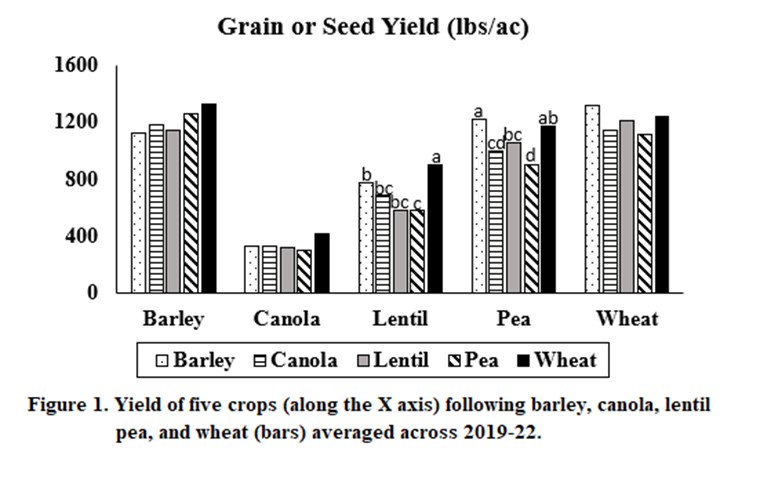Crop Matrix Study
Benefits of Rotation on Wheat and on Crops Following Wheat – Year 4
Patrick Carr, McKenna Volkman, Sally Dahlhausen, Sherry Bishop, Simon Fordyce, and Heather Fryer
MSU Central Agricultural Research Center
Introduction
Over 5.5 million acres of wheat were planted in Montana during 2020 (Sommer, 2021). This amount of wheat was split between winter (1.6 million acres) and spring (4 million acres) types. Barley was the next most widely planted annual crop in the state (890,000 acres), followed by pea (490,000 acres), lentil (370,000 acres), and canola (155,000 acres. These numbers demonstrate the importance of wheat but also barley to Montana farmers.
Earlier research demonstrated the impact that previous crops can have on wheat in central Montana (e.g., Chen et al., 2012; Lin and Chen, 2014; Miller and Holmes, 2005), though this work largely focused on crop sequence studies limited to a few years in length. The impact of rotating wheat with a different crop in a longer-term crop rotation (≥ 4 years) generally was not considered central Montana. Montana farmers have expressed the need for research documenting the impact of crop rotation on wheat and on crops following wheat to scientists at the MSU Central Agricultural Research Center. The objectives of this study are to determine the rotation impacts of: (1) barley, canola, lentil, and pea on grain yield and quality of wheat, and (2) wheat rotation impacts on the grain or seed yield of other crops that follow.
Methods
Twenty-five possible two-year sequences of barley, canola, lentil, pea, and spring wheat (e.g., wheat [YR 1]-pea [YR 2]) were established in an experimental design at the Central Agricultural Research Centers (CARC) near Moccasin in 2018. The second year of each sequence was completed in 2019; the rotation was repeated in 2020-21 with plans for the rotation to be repeated a third time in 2022-23.
Results
Preliminary results indicate that wheat yield following lentil was equal or greater than wheat yield following the other four crops in 2019, 2020, and 2022, while no differences were detected when wheat followed the five previous crop treatments under severe drought in 2021 (data not presented). Conversely, lentil and pea yields were greater following wheat or barley than following pulse crops (i.e., lentil and pea) across 2019 through 2022, while differences where not detected across previous crop treatment for barley or canola (Figure 1). These preliminary data suggest that rotational benefits occur when wheat proceeds pulse crops in central Montana, while lentil rotational benefits occur when followed by wheat.

References
Chen, C., K. Neill, M. Burgess, and A. Bekkerman. 2012. Agronomic benefit and economic potential of introducing fall-seeded pea and lentil into conventional wheat-based crop rotations. Agron. J. 104:215-224.
Lin, R. and C. Chen. 2014. Tillage, crop rotation, and nitrogen management strategies for wheat in central Montana. Agron. J. 106:475-485.
Miller, P.R., and J.A. Holmes. 2005. Cropping sequence effects of four broadleaf crops on four cereal crops in the northern Great Plains. Agron. J. 97:189-200.
Sommer, E. 2020. Montana agricultural Statistics (accessed at https://www.nass.usda.gov/ Statistics_by_State/Montana/Publications/Annual_Statistical_Bulletin/2021/Montana-Annual-Bulletin-2021.pdf.

